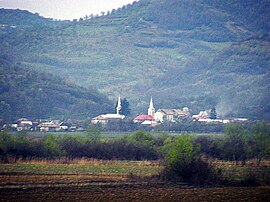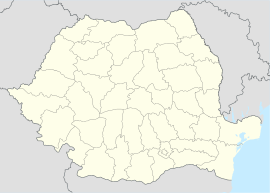world.wikisort.org - Romania
Braniștea (Hungarian: Árpástó) is a commune in Bistrița-Năsăud County, Transylvania, Romania. It is composed of three villages: Braniștea, Cireșoaia (Magyardécse; German: Bellsdorf) and Măluț (Omlásalja).
Braniștea
Árpástó | |
|---|---|
Commune | |
 View of Braniștea village | |
 Location in Bistrița-Năsăud County | |
 Braniștea Location in Romania | |
| Coordinates: 47°10′22″N 24°3′55″E | |
| Country | Romania |
| County | Bistrița-Năsăud |
| Government | |
| • Mayor (2020–2024) | Tamás Martonos (UDMR) |
| Area | 41.64 km2 (16.08 sq mi) |
| Elevation | 245 m (804 ft) |
| Population (2011)[1] | 3,047 |
| • Density | 73/km2 (190/sq mi) |
| Time zone | EET/EEST (UTC+2/+3) |
| Postal code | 427010 |
| Vehicle reg. | BN |
| Website | www |
Geography
The commune lies on the Transylvanian Plateau, on the left bank of the Someșul Mare River. It is located in the western part of the county, on the border with Cluj County, at a distance of 9 km (5.6 mi) from the town of Beclean and 40 km (25 mi) from the county seat, Bistrița; the city of Dej is 17 km (11 mi) to the west, in Cluj County.
Braniștea borders Unguraș village to the south, Sânmărghita village to the west, Reteag and Uriu villages to the north, Cristeștii Ciceului and Coldău villages to the northeast, the town of Beclean to the east, and Rusul de Jos and Malin villages to the southeast.[2]
Demographics
At the 2011 census, 62.7% of inhabitants were Hungarians and 37.1% Romanians.[3] At the 2002 census, 60.6% were Reformed, 34.6% Romanian Orthodox, 2.4% Seventh-day Adventist and 1.1% Pentecostal.
Natives
- Victor Mureșan (1881–1951), priest, delegate at the Alba Iulia National Assembly of December 1, 1918
- Valer Săsărman (1969–2021), footballer
References
- "Populaţia stabilă pe judeţe, municipii, oraşe şi localităti componenete la RPL_2011" (XLS). National Institute of Statistics.
- "Prezentare locală". www.branisteabn.ro (in Romanian). Braniștea town hall. Retrieved November 20, 2021.
- Romanian census data, 2011 Archived 2016-01-21 at the Wayback Machine; retrieved on April 18, 2012

Другой контент может иметь иную лицензию. Перед использованием материалов сайта WikiSort.org внимательно изучите правила лицензирования конкретных элементов наполнения сайта.
WikiSort.org - проект по пересортировке и дополнению контента Википедии
